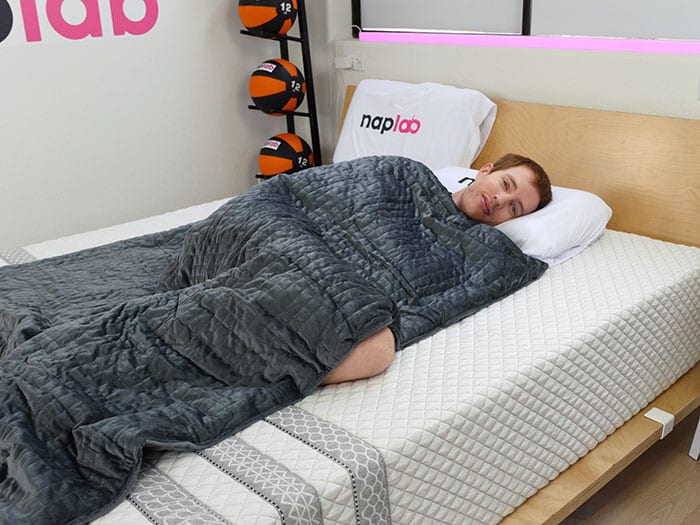The average person spends about 26 years sleeping and seven years trying to fall asleep, reports Huffington Post.
Given these facts, it makes sense to choose a sleep position that benefits your health. If you have neck or back pain, the right posture can help you get better sleep and relieve aches.

For example, Johns Hopkins Medicine recommends sleeping on your back to alleviate low back pain. Individuals who snore or have sleep apnea, on the other hand, may benefit from resting on their side or stomach.
DePaul University says that back sleeping puts the least amount of pressure on the spine. This brings up the question, how to sleep on your back comfortably?
If you’re a side sleeper or stomach sleeper, you may have trouble falling asleep in a different position. That’s what we’re going to discuss today.
Below we’ll show you how to train yourself to sleep on your back and why it’s worth making the switch.
What is the healthiest way to sleep on your back?
The way you sleep has a direct impact on your health and well-being. For instance, sleeping in the same position every night may trigger back, neck, or shoulder pain, warns the Cleveland Clinic.
Experts recommend switching sleep positions every now and then to take some of the pressure off your spine and joints. If you always sleep on your stomach, you may wake up with:
- Neck pain, a common issue if your pillow is too tall.
- Lower back pain, which tends to affect stomach sleepers if their spine is out of alignment due to insufficient mattress support.
As the Cleveland Clinic notes, side and back sleeping may prevent or reduce spinal pain. When you rest on your back, your weight is evenly distributed throughout the spine and discs.
Using a memory foam pillow can further contribute to a healthy back by keeping your cervical spine in neutral alignment.

While there’s no one right way to sleep, some positions are better than others. What matters most is to choose one that keeps your head, neck, and spine aligned. But you also need to consider your individual needs.
Johns Hopkins Medicine recommends sleeping face up to relieve back pain. However, this position may not be the best choice for pregnant women and people with sleep apnea or acid reflux. In some cases, it may also worsen neck pain.
Note that you may be able to sleep on your back even if you have an underlying condition. For example, the Cleveland Clinic suggests resting your head on a memory foam or latex pillow when sleeping face up to relieve sleep apnea symptoms.
Is it better to sleep on your back?
Before going any further, let’s take a closer look at the potential benefits of back sleeping.

- This position not only reduces stress on the spine but also takes the pressure off your head and neck.
- Back sleeping may also delay the appearance of facial wrinkles by keeping you from pressing your face into the pillow. The so-called sleep wrinkles tend to be perpendicular to expression lines and occur around the mouth, nose, chin, forehead, and eyes.
- Last, the supine position—or back sleeping—may help prevent headaches. Sleeping on your stomach, on the other hand, causes your neck to twist, which may worsen this condition.
A study conducted on 400 women aged 20 to 70 years found that roughly 40% of their sleep time was spent in the supine position. If lying flat on your back feels unnatural, there are ways to increase your comfort and enjoy a better night’s sleep.
Back Sleepings & Nightmares | Did you know that back sleepers report having more nightmares than any other sleeping position? The exact reason for this is a bit disputed, but the change in breathing pattern is likely a big contributing factor. Back sleepers may also be at a higher risk for snoring or developing sleep apnea.
How to Sleep on Your Back
Changing your sleep position takes time. Don’t expect it to feel comfortable from day one. Depending on your needs, you may want to invest in a quality mattress and new pillows to adjust the way you sleep.

DePaul University, for instance, recommends using pillows under your neck and knees when sleeping face up. Look for a pillow that fills the space between your neck and the mattress. This ensures proper spinal alignment and may prevent or reduce neck pain.
Also, note that sleep itself and not just the sleep position affects muscle and joint health, suggests a large-scale study. Researchers say that sleeping problems may be responsible for one in 15 to 20 of all new cases of chronic musculoskeletal pain.
If you have trouble sleeping, it may be time to make a change. Use these strategies to train yourself to sleep on your back for better health.
#1. Find a Comfortable Position
Generally, there are two ways to sleep on your back: the Starfish and Savasana.
The Starfish sleeping position involves lying on your back with your legs spread apart and your arms pointed upward.

The Savasana sleeping position, or the corpse pose, involves sleeping on your back with your arms by your sides and your legs extended in front of you.
Try each position to see which one is the most comfortable. Start by lying on your back for 10 minutes or longer every night. Take deep breaths and relax your body so you can fall asleep.

It’s perfectly normal to wake up in a different position in the first few weeks. Your mind and body need time to adjust to back sleeping. Make a habit out of falling asleep on your back and return to this position if you wake up at night.
#2. Maintain Proper Body Alignment
The University of Rochester recommends keeping your head, shoulders, and hips aligned during sleep, no matter what position you choose. Poor body alignment can lead to muscle aches and neck, back, or hip pain.
For example, keeping your neck twisted to one side during sleep may result in cervical pain and stiffness. There is also the risk of waking up with your neck locked in that position.
This brings us to the next point…
#3. Use Pillows to Keep Your Body in Alignment
If you lay on your back, you may notice gaps between your body and the mattress. These gaps can put stress on your muscles, joints, and soft tissues.
To keep your body in alignment during sleep, place small pillows under your neck, knees, or lower back.


How do you sleep with a pillow?
Knee pillows, for instance, can reduce stress on your spine and help maintain the lumbar curve, says the University of Rochester. If you don’t have a knee pillow, use a rolled towel.
Rest your head on a contoured pillow made from latex or memory foam. Make sure the pillow isn’t too high or too low. You may also fold a towel into thirds and place it under your neck for optimal support.

However, this doesn’t mean you must use two or three pillows when sleeping on your back. It all comes down to your individual needs. PhysioMed recommends the following:
- Use a thin pillow that’s high enough to support your head. Make sure it doesn’t cause your chin to tuck.
- Consider investing in a contoured or orthopedic pillow for better neck support.
- Place a small pillow under your knees to reduce hip or knee pain.
- Roll or fold a towel and place it under the arch of your back if the mattress doesn’t offer adequate support.
- Rest your arm(s) on a small pillow to relieve shoulder pain when sleeping face up. Place another one under your shoulder blade if necessary.
#4. Choose a Supportive Mattress
Pillow support is essential for proper body alignment—and so is the mattress you sleep on.
If you wake up with back pain that takes longer than five minutes to subside, your mattress might be the culprit. PhysioMed offers some tips on how to assess your mattress so you can decide whether or not you need a new one:
- Place your hand with the palm down between your lumbar curvature and the mattress while lying face up.
- If you can easily slide your hand, your mattress is okay.
- If you notice a gap or find it difficult to slide your hand, the mattress is either too hard or too soft.
The same source reports that memory foam mattresses offer optimal support by molding to your body.
The downside is that the foam retains heat, which may interfere with your sleep. However, many manufacturers are now using gel foam and other materials with cooling properties.
What matters most is to choose a model that supports the natural curves of your spine. Try out several mattresses before purchasing one. Take into account the following aspects:
- Use a medium-firm mattress if you have lower back pain.
- Extremely firm mattresses may affect sleep quality and worsen back pain, warns Harvard Health.
- A mattress that’s too soft, on the other hand, may cause your joints to twist during sleep, resulting in pain and aches.
- If you weigh more, you may find you need a firmer mattress to help create additional support.
Generally, firm and medium-firm mattresses can make it easier to sleep on your back. Soft mattresses may cause lumbar hyperextension, leading to back pain.
#5. Try a Weighted Blanket
Here’s another trick for sleeping on your back: use a weighted blanket to keep your body from tossing and turning.

In one study, men and women with moderate insomnia reported a better night’s sleep after using weighted blankets. They also found it easier to fall asleep and felt more refreshed in the morning.
Also known as gravity blankets, these products weigh anywhere between five and 25 pounds. Their heavy weight construction can make it easier to sleep face up and keep you from turning onto your side. Ideally, choose a model that’s about 10% of your body weight.
Give Your Body Time to Adjust
Now that you know how to sleep on your back, be patient and give your body time to adjust. Don’t expect to stay still the entire night.
Most people change their sleep positions 11 to 45 times per night. It’s perfectly normal to fall asleep on your back and turn to your side later on.
Use these tips to develop your new habit and get more shuteye. If all else fails, place two pillows on either side of your body. This should keep you from rolling around during sleep.
FAQ
Sleeping on your back tends to leave sleepers feeling exposed and is not really conducive for cuddling or spooning with partners. Back sleeping also allows your tongue to rest in your mouth which can aggravate sleep apnea or increase snoring.
Yes. Sleeping on your back is one of the healthiest sleeping positions and is considered to be a neutral position for your head, neck, and spine.
Start by using pillows or other props to support your side, legs, or others areas and promote back sleeping. Switching to a firmer mattress is another great option.



